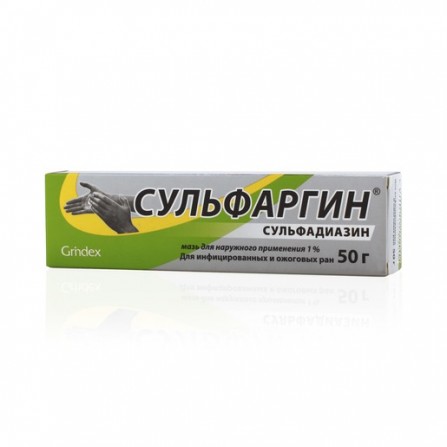More info
Release form
Ointment
Composition
1 g silver sulfadiazine 10 mg. Excipients: Vaseline oil, propylene glycol, cetyl stearyl alcohol, glycerol monostearate 40-55, polysorbate 80, methyl para-hydroxybenzoate, propyl para-hydroxybenzoate, purified water.
Pharmacological effect
Antimicrobial agent for broad-spectrum sulfanilamide. It has a bactericidal effect. The drug is active against gram-positive and gram-negative bacteria (Escherichia coli, Proteus spp., Staphylococcus spp., Klebsiella spp.), As well as Candida spp. Fungi. and dermatophytes. The bactericidal properties of Sulfargin ointment are due to the activity of silver ions, which are released in the wound as a result of the dissociation of the silver sulfadiazine salt; the release of silver ions occurs gradually (moderate dissociation), ensuring the constancy of the antimicrobial action. The bactericidal activity of silver ions is complemented by the bacteriostatic effect of sulfadiazine (also released during the dissociation of the silver salt of sulfadiazine). Sulfargin is characterized by moderate osmotic activity and does not possess necrolytic properties. When externally applied ointment, it is possible to absorb up to 1% of silver ions and up to 10% of sulfadiazine from the total amount of sulfadiazine silver salt applied to the wound from a damaged burn or wound surface.
Pharmacokinetics
Data on the pharmacokinetics of the drug Sulfargin not provided.
Indications
In adults and children older than 1 year for the prevention and treatment of purulent wounds and burns with mild exudation, as well as trophic ulcers, pressure sores: - when processing fresh burn surfaces for preventing infection development - for treating wound and burn surfaces in the first stage of the wound process with severe exudation - for the treatment of wounds and burns I-IIIA degree in the second and third stages of the wound process - for the treatment of trophic ulcers, bedsores, nonhealing wounds (including stump wounds).
Contraindications
- pregnancy - lactation period - marked deficiency of glucose-6-phosphate dehydrogenase - children's age up to 1 year - hypersensitivity to sulfonamides. Sulfargin should not be used for the treatment of deep purulent wounds and burn surfaces with abundant exudation.
Use during pregnancy and lactation
The drug is contraindicated in pregnancy and lactation.
Dosage and administration
Apply externally. After surgical treatment of the wound and removal of necrotic tissue, the ointment is applied to the damaged surface with a thin layer (2-4 mm) under a dressing or by an open method. The dressing is changed 1-2 times / day or less. The maximum single dose - 300 g. Duration of treatment - up to 3 weeks.
Side effects
Systemic reactions: with prolonged use of Sulfargin on extensive burn surfaces, there are possible disorders of the digestive system and changes in the peripheral blood pattern (leukopenia), dyspeptic symptoms and skin manifestations of allergic reactions characteristic of sulfa drugs. Local reactions: rarely - short-term local irritation (burning, pain) that usually disappear on their own within 5-10 minutes after applying the dressing with ointment.
Overdose
Data on drug overdose Sulfargin not provided.
Interaction with other drugs
Data on drug interactions drug Sulfargin not provided.
special instructions
When applying the ointment on a wide surface, it is necessary to control the functional state of the kidneys, liver and the content of blood cells; assign patients with abundant alkaline drink.





